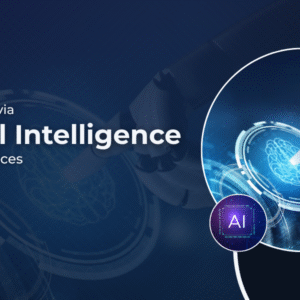Introduction
The explosive growth of AI technologies
In 2025, artificial intelligence (AI) will formally take center stage as the primary driver of the industrial revolution, making it more than simply another tech year. We’re discussing artificial intelligence (AI), which is revolutionizing whole sectors rather than just powering applications and smart assistants. With worldwide AI investment anticipated to exceed $300 billion by the end of the year, it is no longer a nice-to-have, but rather an essential tool in every competitive business’s digital toolbox.
AI development services now extend far beyond traditional software engineering. They’re incorporating machine learning algorithms, computer vision, natural language processing (NLP), and predictive analytics to solve complex business challenges. Businesses are seeking tailor-made AI solutions that are intelligent but also adaptive and scalable.
From predictive maintenance in manufacturing to hyper-personalized marketing in retail, AI is doing what was once science fiction. The industries that are quickest to adopt and adapt are the ones reaping massive ROI. Companies that invested in AI early have seen operational costs reduced by up to 40% and customer satisfaction scores shoot up by over 60%. These aren’t future dreams—they’re today’s stats.
Why businesses can’t ignore AI anymore
Ignoring AI in 2025 is like ignoring the internet in 2000—you’d simply be left behind. The customer demands of today require faster responses, deeper insights, and seamless experiences, all of which AI delivers at scale. And it’s not just about automation or data crunching anymore. AI has evolved into a creative, strategic, and analytical powerhouse that aids in decision-making and drives revenue.
If a business still hesitates to jump into the AI pool, it risks being swept away by more agile competitors. AI gives companies the power to scale like never before. It’s helping startups punch above their weight and allowing enterprise giants to stay nimble in a changing landscape. Simply put, it’s no longer about if you should adopt AI, but how fast you can do it and who can help you do it right.
AI-Powered Automation Solutions
Streamlining workflows with RPA
Robotic Process Automation (RPA) is the cornerstone of AI-driven automation. Think of it as a digital workforce that never sleeps, never makes mistakes, and completes tasks at lightning speed. These bots take over repetitive tasks—everything from data entry and invoice processing to scheduling and compliance reporting.
In 2025, RPA is more intelligent than ever. It’s no longer about just automating tasks; it’s about optimizing them. Thanks to AI integration, RPA tools can now understand context, learn from behavior, and make decisions based on predefined goals. This shift from rule-based to intelligence-based automation is what’s allowing businesses to do more with less.
Companies that adopt AI-powered RPA are cutting labor costs, boosting productivity, and reducing error margins dramatically. It’s a game-changer for industries like healthcare, finance, logistics, and even legal services. Imagine a hospital where AI bots handle patient intake, insurance verification, and data entry while nurses focus solely on patient care. That’s not the future—it’s now.
Real-world applications in finance, healthcare, and logistics
- Finance: Banks are using RPA to streamline KYC processes, automate loan approvals, and monitor transactions for fraudulent activity in real-time.
- Healthcare: Medical institutions are implementing bots to manage patient records, handle billing cycles, and even assist in clinical documentation.
- Logistics: AI-driven automation is optimizing supply chain logistics, automating order management, and managing inventory with near-zero human intervention.
What’s powerful about automation in 2025 is its versatility. Whether you’re a small business looking to save time or a global enterprise aiming to optimize a multi-layered supply chain, there’s an AI-powered automation service tailored for you.
Natural Language Processing (NLP) Services
Breaking the language barrier in business
Natural Language Processing (NLP) is one of the most transformative AI services of this era. It’s allowing machines to understand, interpret, and even generate human language with remarkable accuracy. In 2025, NLP is not just about chatbots anymore—it’s about seamless communication across platforms, languages, and customer demographics.
With multilingual NLP models, businesses are finally able to go global without the usual translation bottlenecks. Customer service centers can now handle queries in over 100 languages, all without hiring a massive staff. AI translators have reached near-human accuracy, enabling real-time translations in video calls, text chats, and even marketing copy.
But it doesn’t stop at translation. NLP is helping machines understand customer sentiment, detect sarcasm, and even predict what a user wants based on the tone of their message. This depth of insight is pushing companies to completely rethink their customer experience strategies.
NLP’s impact on customer support and content creation
- Customer Support: AI-powered virtual assistants are resolving up to 80% of customer queries without any human involvement. These systems learn over time, meaning they get smarter with each interaction.
- Content Creation: From writing SEO blogs and product descriptions to generating ad copies and social media posts, NLP tools like GPT-based models are helping marketers scale content like never before.
Moreover, NLP-driven analytics tools are enabling businesses to mine insights from customer feedback, reviews, and social media chatter. Imagine being able to gauge the public perception of your brand across thousands of conversations in seconds—that’s the power of modern NLP.
Computer Vision and Image Recognition
Transforming manufacturing and retail industries
Computer vision is turning traditional industries upside down by giving machines the ability to “see” and understand visual data just like humans—but with more precision and zero fatigue. In 2025, this technology is being deployed everywhere—from factory floors to retail store shelves.
In manufacturing, computer vision systems are identifying defects in products faster than human inspectors ever could. Whether it’s detecting a micro-crack in a car part or checking alignment on a circuit board, these systems perform quality control with near-perfect accuracy. The result? Fewer returns, higher customer satisfaction, and massive cost savings.
Retail is also seeing a major transformation. Imagine walking into a store where cameras track inventory in real-time, restock alerts are automatically generated, and even theft prevention is handled through AI surveillance. Smart checkout systems are eliminating queues, with facial recognition and computer vision helping customers walk out of the store with their purchases automatically billed.
The real beauty of computer vision in 2025 is its integration with edge devices and the cloud. That means the processing is faster, the insights are real-time, and the scalability is limitless.
Use cases: Quality inspection, facial recognition, and security
- Quality Inspection: Automated visual inspections reduce errors by up to 95% compared to manual checks, enhancing product quality across industries.
- Facial Recognition: Airports and secure facilities are using facial recognition for faster and more secure identity verification.
- Security Systems: AI-powered surveillance systems can detect suspicious behavior, alert authorities, and even track individuals across multiple camera feeds in real-time.
Computer vision is also being used in agriculture to monitor crop health, in transportation to assess road conditions, and in real estate for virtual staging. It’s more than a tool—it’s a revolution in visual intelligence.
AI-Driven Predictive Analytics
Leveraging data for strategic decision-making
Data is the new oil, but without refining it, it’s just a mess of numbers. Predictive analytics—powered by AI—takes that raw data and transforms it into actionable insights. In 2025, predictive analytics is the compass guiding business strategy across industries.
Businesses now rely on AI to forecast everything from customer churn to inventory needs and financial trends. It’s no longer about “what happened” but “what will happen next.” These insights empower leaders to make data-driven decisions with a degree of confidence that was unthinkable just a few years ago.
By analyzing historical data, user behavior, market trends, and even external variables like weather or political events, AI models are predicting outcomes with astonishing accuracy. The more data they process, the smarter they get. And thanks to cloud computing, these models are available to companies of all sizes.
Real-time insights into supply chain, marketing, and sales
- Supply Chain: Predictive models can foresee supply disruptions, helping businesses reroute shipments or adjust procurement strategies proactively.
- Marketing: AI analyzes user data to predict buying behavior, allowing for personalized marketing campaigns that convert better.
- Sales Forecasting: Businesses are using predictive analytics to forecast revenue, identify high-value prospects, and optimize sales team performance.
The ability to forecast demand and optimize operations in real-time gives businesses a huge competitive edge. Whether you’re a small retailer or a multinational corporation, AI-driven predictive analytics can mean the difference between success and stagnation.
AI in Cybersecurity
Intelligent threat detection and response
In an era where cyber threats are more sophisticated than ever, traditional firewalls and antivirus software just don’t cut it anymore. Enter AI-powered cybersecurity—your smartest digital watchdog. In 2025, AI is not just detecting threats; it’s anticipating them.
Machine learning models can analyze network behavior, detect anomalies, and flag suspicious activity long before a human analyst would even notice. These systems learn from every new threat, making them increasingly effective over time. Whether it’s phishing attempts, DDoS attacks, or insider threats, AI is staying one step ahead of the bad guys.
AI also plays a critical role in automating response mechanisms. Instead of waiting for human intervention, AI systems can isolate infected systems, shut down malicious processes, and even deploy countermeasures in real-time.
Enhancing data privacy and risk mitigation
- Data Protection: AI identifies vulnerabilities in your infrastructure and suggests patches or updates before they’re exploited.
- Risk Scoring: It evaluates the risk level of each device, user, or system and assigns scores to help prioritize security efforts.
- Compliance: From GDPR to HIPAA, AI helps ensure that your data handling practices meet regulatory requirements.
For organizations storing sensitive information—be it financial data, medical records, or proprietary business strategies—AI in cybersecurity isn’t optional. It’s essential. With cybercrime expected to cost the world $10.5 trillion annually by 2025, investing in AI security measures could be the smartest move your company can make.
Machine Learning as a Service (MLaaS)
Accessible AI for businesses of all sizes
Not every business has a data science team on standby. That’s where Machine Learning as a Service (MLaaS) steps in. MLaaS democratizes access to powerful machine learning tools, putting AI capabilities in the hands of startups, SMBs, and enterprises alike—without needing to hire an army of data scientists.
In 2025, MLaaS platforms are thriving, offering plug-and-play solutions that allow companies to build, train, and deploy machine learning models with ease. These platforms are hosted on the cloud, making them highly scalable, cost-effective, and instantly available from anywhere in the world.
The true appeal of MLaaS lies in its simplicity. Businesses can upload their data, choose the kind of model they want (classification, regression, clustering, etc.), and let the platform do the rest. No need to write complicated algorithms or maintain infrastructure. Services like AWS SageMaker, Google Cloud AI, and Azure Machine Learning are enabling this AI revolution.
Benefits of scalable, cloud-based machine learning
- Affordability: Pay-as-you-go models make AI accessible without massive upfront investment.
- Flexibility: Choose from a wide range of pre-trained models or build your own from scratch.
- Speed: Train and deploy models in hours, not weeks.
- Security: Built-in data encryption and compliance with international standards like ISO and SOC.
MLaaS is being used in fraud detection, demand forecasting, customer segmentation, and sentiment analysis. Whether you’re predicting which product will sell next quarter or segmenting customers for a new campaign, MLaaS makes it all possible—with just a few clicks.
This “AI as a utility” model is reshaping the way companies operate. It levels the playing field, giving every business—from local boutiques to global brands—the power to make smarter decisions with machine learning.
Generative AI and Content Creation
Revolutionizing marketing and entertainment
If 2023 was the year generative AI hit the mainstream, then 2025 is the year it truly matured. Generative AI is now central to how content is created, whether it’s for marketing, entertainment, journalism, or education. Tools powered by models like GPT, DALL·E, and others are producing everything from blog posts and ad scripts to music, art, and entire movie scenes.
Marketers are using generative AI to draft high-converting emails, brainstorm campaign ideas, and auto-generate landing pages. Brands are building chatbots that sound human, write with flair, and understand user intent better than ever before. The time and cost savings are huge, but so is the creative potential.
In the entertainment world, generative AI is co-authoring screenplays, composing soundtracks, and animating videos. Independent creators are empowered like never before. What once required a full studio and budget now takes a laptop and the right tools.
Ethical concerns and creative possibilities
- Plagiarism and Authenticity: As AI creates content at scale, concerns over originality and creative credit have intensified. Ensuring transparency in AI-generated content is now a best practice.
- Deepfakes: While exciting for entertainment, deepfakes pose risks for misinformation. Regulation is catching up, but responsible use is critical.
- Collaboration vs. Replacement: Generative AI is best viewed as a collaborator, not a replacement. It enhances human creativity rather than diminishes it.
When used ethically, generative AI empowers creators to experiment more, iterate faster, and produce content that resonates deeply with audiences. It’s not just changing how content is made—it’s transforming who gets to make it.
Industry-Specific AI Applications
AI in healthcare: Diagnostics and treatment planning
The healthcare industry has seen some of the most life-changing applications of AI. In 2025, AI isn’t just assisting doctors—it’s saving lives. From diagnostics to drug discovery, AI systems are operating at the heart of modern medicine.
AI-powered diagnostic tools analyze X-rays, MRIs, and CT scans with accuracy levels often exceeding human radiologists. They detect conditions such as cancer, pneumonia, and neurological disorders in minutes. These tools provide second opinions, flag potential issues, and ensure no critical detail is missed.
AI is also helping personalize treatment plans by analyzing genetic data, patient history, and real-time vital signs. This means more accurate prescriptions, fewer side effects, and better patient outcomes.
In surgery, AI assists robotic systems for more precise, minimally invasive procedures. Hospitals are also using AI for administrative tasks—like scheduling, billing, and patient flow optimization—to reduce wait times and improve care delivery.
AI in finance: Fraud detection and robo-advisors
In finance, AI is reshaping everything from how banks handle transactions to how individuals invest their money. Fraud detection has reached new heights, with AI models analyzing billions of transactions in real time to detect anomalies and stop fraud before it occurs.
Robo-advisors are making investment advice accessible to the average person. These platforms analyze market trends, user goals, and risk profiles to offer personalized portfolio recommendations—all at a fraction of the cost of human advisors.
Banks and fintech companies are also using AI to enhance customer service, approve loans faster, and manage credit risk more accurately. With AI, finance isn’t just smarter—it’s more inclusive, secure, and efficient.
How to Choose the Right AI Development Partner
Key criteria: Experience, transparency, and scalability
Not all AI service providers are created equal. Choosing the right development partner can make or break your AI journey. Here’s what to look for:
- Proven Experience: Look for vendors with a strong portfolio in your industry and a deep understanding of relevant AI technologies.
- Transparent Process: A good partner will walk you through the AI development process, explain the models used, and be open about limitations.
- Scalability: Choose a provider that offers scalable solutions, so your AI infrastructure can grow alongside your business.
Avoid “black box” vendors who don’t explain how their algorithms work. Transparency ensures you can audit results, trust outputs, and comply with data regulations.
Future Trends in AI Development Services
Merging AI with IoT and blockchain
As we step deeper into 2025, the convergence of AI with other disruptive technologies like the Internet of Things (IoT) and blockchain is taking center stage. This fusion is unlocking new dimensions of automation, data integrity, and intelligence across industries.
When AI meets IoT, we get smarter ecosystems. Think smart cities where traffic lights adjust based on real-time congestion, or smart factories where machines predict maintenance needs and reorder parts automatically. AI processes the massive volumes of data generated by IoT devices, extracting insights and making autonomous decisions in real-time.
Blockchain, on the other hand, brings trust and security to AI systems. Data used to train AI models can be logged on a blockchain, ensuring it’s tamper-proof and traceable. This is especially critical in industries like finance and healthcare, where data integrity is non-negotiable. Moreover, smart contracts powered by blockchain and AI are automating everything from insurance claims to royalty payments, reducing the need for intermediaries and boosting efficiency.
Together, these technologies are not just evolving—they’re co-evolving. The result is a more connected, intelligent, and secure digital landscape.
Autonomous systems and self-learning algorithms
Another major trend in 2025 is the rise of autonomous AI systems—solutions that not only act independently but also learn and evolve without human intervention. Self-driving vehicles, autonomous drones, and robotic assistants are no longer futuristic ideas; they are operational realities.
These systems rely on self-learning algorithms that improve their performance over time by analyzing data, adjusting strategies, and adapting to new environments. For example, autonomous retail robots are now managing inventory, assisting customers, and optimizing floor layouts based on traffic patterns—all in real-time.
In the enterprise world, AI agents are handling negotiations, managing supply chains, and even writing code. They’re becoming digital employees, performing complex tasks that traditionally required human intelligence.
As these technologies mature, businesses will increasingly shift from manual oversight to autonomous execution, creating unprecedented levels of efficiency and innovation.
Conclusion
Artificial Intelligence has evolved from a futuristic concept into a transformative force across every major industry. In 2025, the impact of AI development services is unmistakable—from streamlining operations with RPA and enhancing customer experience with NLP, to transforming healthcare and finance through predictive analytics and industry-specific applications.
The top 7 AI development services—automation, NLP, computer vision, predictive analytics, cybersecurity, MLaaS, and generative AI—are not just tools; they’re catalysts for innovation, efficiency, and competitive advantage. They are reshaping how businesses operate, interact with customers, and plan for the future.
As AI continues to merge with other technologies like IoT and blockchain, the possibilities are endless. However, with great power comes great responsibility. Businesses must focus on ethical AI practices, transparent algorithms, and inclusive development to truly unlock the full potential of artificial intelligence.
Now is the time to act. Whether you’re a startup, a mid-sized company, or an enterprise giant, adopting AI isn’t just a tech upgrade—it’s a strategic imperative for growth, relevance, and success in 2025 and beyond.
FAQs
What are the most popular AI development services in 2025?
The most in-demand AI services in 2025 include AI-powered automation, NLP, computer vision, predictive analytics, AI cybersecurity, MLaaS, and generative AI. These services are revolutionizing industries by improving efficiency, reducing costs, and enhancing customer experiences.
How can AI help small businesses?
AI levels the playing field for small businesses by offering scalable solutions for customer service, marketing, inventory management, and sales forecasting. With affordable MLaaS platforms and user-friendly tools, small businesses can leverage AI without needing in-house expertise.
What are the risks of using AI services?
Some risks include data privacy concerns, ethical misuse, algorithmic bias, and over-reliance on automation. Businesses should partner with trustworthy AI developers and implement transparent, auditable systems to mitigate these risks.
How to ensure the ethical use of AI in business?
Ensure your AI solutions are transparent, explainable, and auditable. Avoid biased datasets, respect user privacy, and comply with data regulations like GDPR. Ethical AI involves continuous monitoring and a commitment to fairness and accountability.
Is AI development expensive for startups?
Not anymore. Thanks to MLaaS and open-source tools, startups can access powerful AI technologies without large upfront investments. Many cloud-based services offer affordable, scalable pricing models that grow with your business needs.








